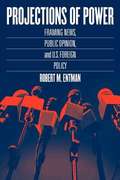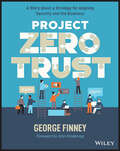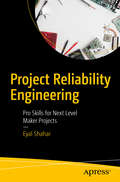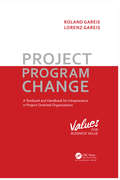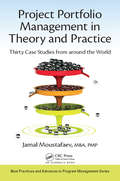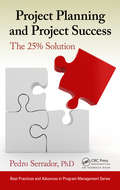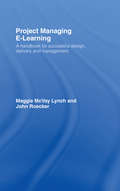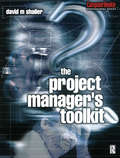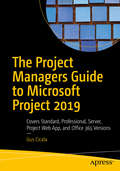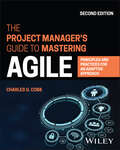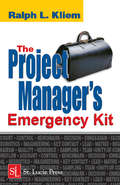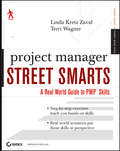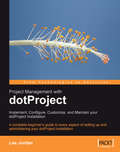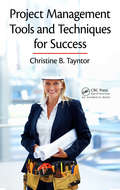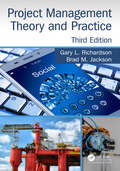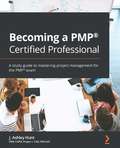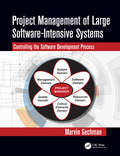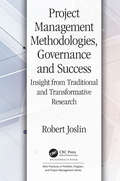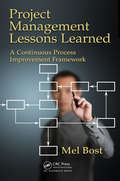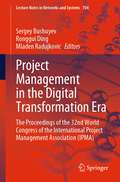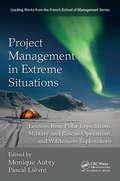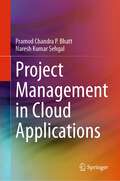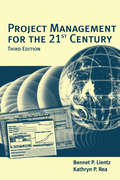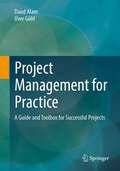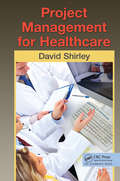- Table View
- List View
Projections of Power: Framing News, Public Opinion, and U.S. Foreign Policy
by Robert M. EntmanTo succeed in foreign policy, U.S. presidents have to sell their versions or framings of political events to the news media and to the public. But since the end of the Cold War, journalists have increasingly resisted presidential views, even offering their own spin on events. What, then, determines whether the media will accept or reject the White House perspective? And what consequences does this new media environment have for policymaking and public opinion? To answer these questions, Robert M. Entman develops a powerful new model of how media framing works -- a model that allows him to explain why the media cheered American victories over small-time dictators in Grenada and Panama but barely noticed the success of far more difficult missions in Haiti and Kosovo. Discussing the practical implications of his model, Entman also suggests ways to more effectively encourage the exchange of ideas between the government and the media and between the media and the public. His book will be an essential guide for political scientists, students of the media, and anyone interested in the increasingly influential role of the media in foreign policy.
Project Zero Trust: A Story about a Strategy for Aligning Security and the Business
by George FinneyImplement Zero Trust initiatives efficiently and effectively In Project Zero Trust: A Story About a Strategy for Aligning Security and the Business, George Finney, Chief Security Officer at Southern Methodist University, delivers an insightful and practical discussion of Zero Trust implementation. Presented in the form of a fictional narrative involving a breach at a company, the book tracks the actions of the company's new IT Security Director. Readers will learn John Kindervag's 5-Step methodology for implementing Zero Trust, the four Zero Trust design principles, and how to limit the impact of a breach. They'll also find: Concrete strategies for aligning your security practices with the business Common myths and pitfalls when implementing Zero Trust and how to implement it in a cloud environment Strategies for preventing breaches that encourage efficiency and cost reduction in your company's security practices Project Zero Trust is an ideal resource for aspiring technology professionals, as well as experienced IT leaders, network engineers, system admins, and project managers who are interested in or expected to implement zero trust initiatives.
Project Reliability Engineering: Pro Skills for Next Level Maker Projects
by Eyal ShaharTurn your projects from a weekend hack to a long-living creation! Loosely drawing from the field known in large software companies as Site Reliability Engineering (SRE), this book distills from these disciplines and addresses issues that matter to makers: keeping projects up and running, and providing means to control, monitor, and troubleshoot them. Most examples use the Raspberry Pi, but the techniques discussed apply to other platforms as well. This book is all about breadth, and in the spirit of making, it visits different technologies as needed. However, the big goal in this book is to create a shift in the reader’s mindset, where weekend hacks are pushed to the next level and are treated as products to be deployed. In that regard, this book can be a stepping stone for hobbyist makers into developing a broader, professional skill set. First, the book describes techniques for creating web-browser based dashboards for projects. These allow project creators to monitor, control, and troubleshoot their projects in real-time. Project Reliability Engineering discusses various aspects of the process of creating a web dashboard, such as network communication protocols, multithreading, and web design, and data visualization. Later chapters cover configuration of the project and the machine it’s running on, and additional techniques for project monitoring and diagnosis. These include good logging practices; automatic log and metrics monitoring; and alerting via email and text messages; A mixture of advanced concepts forms the last chapter of the book, touching on topics such as usage of microservices in complex projects; debugging techniques for object-oriented projects; and fail-safing the project’s software and hardware. What You’ll Learn Monitor and control projects, keep them up and running, and troubleshoot them efficiently Get acquainted with available tools and libraries, and learn how to make your own tools Expand your knowledge in Python, JavaScript and Linux Develop deeper understanding of web technologies Design robust and complex systems Who This Book Is For Members of the maker community with some development skills.
Project. Program. Change
by Roland Gareis Lorenz GareisThis book gives managers an integrative approach to project, program, and change management. It describes the differences between change in projects versus programs with case studies in both areas and the different life cycles. While the project and change comprise much of the book, it is up to date with its emphasis on agile, scrum, and benefits. The book also describes methods to both initiate and manage a change and what must be done for success and business value.
Project Portfolio Management in Theory and Practice: Thirty Case Studies from around the World (Best Practices in Portfolio, Program, and Project Management #24)
by Jamal MoustafaevEvery CEO in the world, if questioned, will always complain that there are a lot of ideas to implement, but, unfortunately, insufficient resources to accomplish them. This book provides a solution to this dilemma by supplying techniques to assess the value of projects, prioritize projects, and decide which projects to implement and which to postpone. In addition, it describes various methods of balancing project portfolios and different strategic alignment models. The book provides thirty real-life project portfolio management case studies from pharmaceutical, product development, financial, energy, telecommunications, not-for-profit and professional services industries.
Project Planning and Project Success: The 25% Solution (Best Practices In Portfolio, Program, And Project Management Ser. #15)
by Pedro SerradorProject planning is generally accepted as an important contributor to project success. However, is there research that affirms the positive impact of project planning and gives guidance on how much effort should be spent on planning? To answer these questions, this book looks at current literature and new research of this under-studied area of proj
Project Managing E-Learning: A Handbook for Successful Design, Delivery and Management
by Maggie McVay Lynch John RoeckerProject Managing E-learning provides an essential framework, based on the globally accepted IPECC model, for planning, designing, delivering, managing and evaluating e-learning projects successfully. It focuses on practical, easy-to-understand methods and offers applications of project management principles in the real world. Illustrated by case studies of projects undertaken in business and academia it provides a step-by-step guide and highlights where projects typically fail. Each chapter begins with a definition and conceptualisation of the process, provides examples of how the process steps may vary dependent on organization or project size and discusses the typical problems organisations face when performing steps in the project management process. Covering all of the essentials as well as cutting-edge technology, it guides designers and managers through all stages of implementing and managing a project. Selected themes include: using focus groups gaining sponsors risk management pedagogical considerations testing quality control how to know when trouble is imminent PM software systems podcasting. The practical framework and sound advice offered in Project Managing E-learning is essential reading for all those who want to successfully implement and manage high quality e-learning in both academic and corporate training settings on time and to budget.
Project Manager's Toolkit
by David Shailer'The Project Manager's Toolkit' provides a quick reference checklist approach to drive an IT development project as well as solve issues that arise in the process. It can be used proactively to set a project on the right course and reactively for solutions to problems. It will:* help identify what needs doing next on an IT project* provide quick reference 'to-do' lists for use throughout the lifecycle of an IT project* answer the need for material that can be used to quality-check project deliverablesIt has been designed so that those on the project team who are facing a problem can pick up the book, turn to a relevant checklist and use it as a "starter-for-ten" to find a solution. For example, how to analyse data for a data-conversion exercise, or how to measure the quality of a project deliverable. 'The Project Manager's Toolkit' therefore provides a fast way to reduce an insolvable problem/issue to a set of smaller solvable ones
The Project Managers Guide to Microsoft Project 2019: Covers Standard, Professional, Server, Project Web App, and Office 365 Versions
by Gus CicalaLearn Microsoft Project 2019 from the perspective of the project manager. This guide is an all-in-one training resource and reference that covers all versions found in the Microsoft Project 2019 suite. It is not a “how-to” manual covering the features and functions of the software, but is designed to explain and demonstrate why those features and functions are important to you as a project manager, allowing you to maximize the value of Microsoft Project 2019. Each aspect of project-manager-specific coverage was selectively compiled by author and Microsoft Project expert Cicala over more than two decades of consulting, project management training, and managing real-world projects using Microsoft Project. Readers will appreciate the robust index and intuitively organized and learning-oriented chapters, and sub-sections for quick reference and problem solving. “Try it” exercises at the close of every chapter help ensure understanding of the content. What You Will Learn Understand key components to the Microsoft Project 2019 solutionReinforce learning via hands-on exercises with step-by-step illustrations Build a plan and work breakdown structure, and manage resources and assignmentsUtilize enterprise project management for creating a project, monitoring, controlling, and trackingExport and communicate project information to an external audienceWho This Book Is ForProject managers with limited time and resources who need to maximize their efficiency with Microsoft Project Answer keys and supporting PowerPoint slides are available for academic instructors upon request.
The Project Manager's Guide to Mastering Agile: Principles and Practices for an Adaptive Approach
by Charles G. CobbTHE PROJECT MANAGER’S GUIDE TO MASTERING AGILE Updated guide to Agile methodologies, with real-world case studies and valuable frameworks for project managers moving to Agile The Project Manager’s Guide to Mastering Agile helps project managers who are faced with the challenge of adapting their project management approach to an Agile environment, showing how these approaches can work jointly to improve project outcomes in any project, with discussion topics and real-world case studies that facilitate hands-on learning. It also provides project managers with the fundamental knowledge to take a leadership role in working with companies to develop a well-integrated, enterprise-level Agile Project Management approach to fit their business. The original edition of this book has been very successful and is used as a graduate-level textbook in several universities. This new edition builds on the success of the original edition and includes updated content from the latest PMBOK Guide, updated sections on stakeholder management, value-driven delivery, adaptive planning, and distributed project management, with an all-new chapter on Hybrid project management. It also includes new case studies on applying an Agile Hardware Development at Tesla and Project Management in a non-software environment. Sample topics covered in The Project Manager’s Guide to Mastering Agile include: Bridging the chasm in project management philosophies, impact on the project management profession, evolution of Agile and Waterfall, and learning to see Agile and traditional plan-driven project management as complementary to each other rather than competitive The roots of Agile and understanding Agile at a deeper level including the Agile manifesto from 2001, adapting an Agile approach to fit a business, and Scrum overview, roles, framework, principles, and values Time-boxing, Kanban, and theory of constraints, Agile estimation overview and estimation practices, and velocity and burn-down/burn-up charts Scaling Agile to an enterprise level, including challenges, obstacles to overcome, implementation considerations, management practices, and enterprise-level Agile transformations With comprehensive, accessible, and highly practical coverage of Agile, a leading project management platform, The Project Manager’s Guide to Mastering Agile is a highly valuable resource for professional project managers, students studying project management, and those studying for PMI’s Agile Certified Practitioner Certification (PMI-ACP).
The Project Manager's Emergency Kit
by PMP, Ralph KliemProject success requires a solid understanding and proper implementation of the tools, techniques, and principles of project management. A reference for both the novice and expert project manager, The Project Manager's Emergency Kit provides you with everything you will need to get your project off to a solid start and overcome any em
Project Manager Street Smarts
by Linda Kretz Zaval Terri WagnerHands-on practice for the most common-and most difficult-project management tasksBreaking into the field of project management is difficult, and the Project Management Institute requires that Project Management Professionals (PMPs) have on-the-job experience before earning their certification. This handy, task-based resource addresses the most common and the most challenging tasks Project Managers face and demonstrates how to perform these tasks.The Street Smarts series is designed to help current or aspiring professionals put their certification to work for them. Full of practical, real world scenarios, each book features actual tasks from the field and then offers step-by-step exercises that teach the skills necessary to complete those tasks.Aimed at anyone looking to gain hands-on experience in the field of project management by offering a unique look at the daily routine of a project managerOffers a variety of real-world scenarios, covering everything from the most common tasks to the most demanding roadblocksWalks you through step-by-step instructions of working with a project: initiating, planning, executing, monitoring and controlling, and closingDemonstrates defining a scope, developing a project charter, creating the work breakdown structure, managing resource allocation, and moreDesigned to provide you with an accurate look into the field of project management, this book offers you a unique and insightful perspective on the demands of a project manager on a day-to-day basis.
Project Management with dotProject: Implement, Configure, Customize, and Maintain your DotProject Installation
by Lee JordanThis book is a fast-paced, practical guide to getting things done with dotProject. It illustrates an easy and effective method to handle projects with the help of extensive real-world examples. The book is for a person or a group of people who are looking for an efficient and flexible project management tool for managing any kind of project. They may be users with technical knowledge such as system administrators or IT professionals, or users with basic computer and internet skills who want a project management tool that they can learn easily without having to learn HTML or a programming language. No prior experience of formal project management is required.
Project Management Tools and Techniques for Success
by Christine B. TayntorEmphasizing that it's much easier and more cost effective to make changes in the planning phases of a project rather than later on, Project Management Tools and Techniques for Success provides an accessible introduction to project management fundamentals. Highlighting approaches for avoiding common pitfalls, it begins with an introduction to p
Project Management Theory and Practice, Third Edition
by Gary L. Richardson Brad M. JacksonProject Management: Theory and Practice, Third Edition gives students a broad and real flavor of project management. Bringing project management to life, it avoids being too sterilely academic and too narrowly focused on a particular industry view. It takes a model-based approach towards project management commonly used in all industries. The textbook aligns with the latest version of the Project Management Institute’s Project Management Body of Knowledge (PMBOK®) Guide, which is considered to be the de facto standard for project management. However, it avoids that standard’s verbiage and presents students with readable and understandable explanations. Core chapters align with the Project Management Institute’s model as well as explain how this model fits real-world projects. The textbook can be used as companion to the standard technical model and help those studying for various project management certifications. The textbook takes an in-depth look at the following areas important to the standard model: Work Breakdown Structures (WBS) Earned Value Management (EVM) Enterprise project management Portfolio management (PPM) Professional responsibility and ethics Agile life cycle The text begins with a background section (Chapters 1–9) containing material outside of the standard model structure but necessary to prepare students for the 10 standard model knowledge areas covered in the chapters that follow. The text is rounded out by eight concluding chapters that explain advanced planning approaches models and projects’ external environments. Recognizing that project management is an evolving field, the textbook includes section written by industry experts who share their insight and expertise on cutting-edge topics. It prepares students for upcoming trends and changes in project management while providing an overview of the project management environment today. In addition to guiding students through current models and standards, Project Management: Theory and Practice, Third Edition prepares students for the future by stimulating their thinking beyond the accepted pragmatic view.
Project Management Professional (PMP)® Certification Study Guide
by J. Ashley HuntThis book is for experienced project managers looking for a common language and best practices in the project management space who wish to gain certification and improve their career growth potential. A minimum of 5 to 7 years of experience in leading and directing projects in a variety of industries will be useful.
Project Management of Large Software-Intensive Systems
by Marvin GechmanThe book describes how to manage and successfully deliver large, complex, and expensive systems that can be composed of millions of line of software code, being developed by numerous groups throughout the globe, that interface with many hardware items being developed by geographically dispersed companies, where the system also includes people, policies, constraints, regulations, and a myriad of other factors. It focuses on how to seamlessly integrate systems, satisfy the customer’s requirements, and deliver within the budget and on time. The guide is essentially a “shopping list” of all the activities that could be conducted with tailoring guidelines to meet the needs of each project.
Project Management Methodologies, Governance and Success: Insight from Traditional and Transformative Research (Best Practices and Advances in Program Management)
by Robert JoslinProject management methodologies, practices, and guidelines are the only explicit information that project managers have and, when properly maintained, should reflect the most current knowledge and guidance to achieve repeatable successful project outcomes. Despite more than 50 years of research in the field of project management, project success r
Project Management Lessons Learned: A Continuous Process Improvement Framework
by Mel BostProject Management Lessons Learned: A Continuous Process Improvement Framework is intended for project managers, PMO professionals, and students of project management who wish to apply performance-based feedback to their process and project improvements. This feedback is the basis for modern process control theory, which is playing a greater and greater role in process design. Readers can apply the Process Feedback Framework, as well as lesson learned from the book’s case studies, to meet challenges that arise now and in the future. <P><P>Special focus is given to technology development in projects and sustainability implications of process design. The book emphasizes rationale for a robust project risk management program which capitalizes on lessons learned. PMO leaders can use the organizational dynamics and systems archetypes applications presented in the book to define project policy standards and procedures to align PMO behaviors with performance objectives. <P><P>Project Management Lessons Learned: A Continuous Process Improvement Framework is intended for project managers, PMO professionals, and students of project management who wish to apply performance-based feedback to their process and project improvements. This feedback is the basis for modern process control theory, which is playing a greater and greater role in process design. Readers can apply the Process Feedback Framework, as well as lesson learned from the book’s case studies, to meet challenges that arise now and in the future. Special focus is given to technology development in projects and sustainability implications of process design. The book emphasizes rationale for a robust project risk management program which capitalizes on lessons learned. PMO leaders can use the organizational dynamics and systems archetypes applications presented in the book to define project policy standards and procedures to align PMO behaviors with performance objectives.
Project Management in the Digital Transformation Era: The Proceedings of the 32nd World Congress of the International Project Management Association (IPMA) (Lecture Notes in Networks and Systems #704)
by Sergey Bushuyev Ronggui Ding Mladen RadujkovicThis book presents the proceedings of the 32nd World Congress of the International Project Management Association (IPMA). Digitalization is changing many fields of development and accelerating the global economic world. This challenge concerns project management as the driver of change. More than 1000 participants of the 32nd IPMA World Congress are an international community of the best experts and practitioners of project management. The Program Committee of the Congress includes more than 30 experts from Europe, Asia, America, and Australia, heads of large companies, and leading scientists and practitioners representing various areas of management, economics, and digital technology. The project management community discussed the challenges and prospects of the digital age, to find solutions to the problems that it poses to project management. The discussion took place in different formats – presentations, master classes, panel discussions, business games, and seminars that will be conducted by the world’s leading experts in the project management field.
Project Management in Extreme Situations: Lessons from Polar Expeditions, Military and Rescue Operations, and Wilderness Exploration (Leading Works from the French School of Management)
by Monique Aubry Pascal LievreThe growing complexity of projects today, as well as the uncertainty inherent in innovative projects, is making obsolete traditional project management practices and procedures, which are based on the notion that much about a project is known at its start. The current high level of change and complexity confronting organizational leaders and managers requires a new approach to projects so they can be managed flexibly to embrace and exploit change. What once used to be considered extreme uncertainty is now the norm, and managing planned projects is being replaced by managing projects as they evolve. <P><P>Successfully managing projects in extreme situations, such as polar and military expeditions, shows how to manage successfully projects in today’s turbulent environment. Executed under the harshest and most unpredictable conditions, these projects are great sources for learning about how to manage unexpected and unforeseen situations as they occur. This book presents multiple case studies of managing extreme events as they happened during polar, mountain climbing, military, and rescue expeditions. <P><P>A boat accident in the Artic is a lesson on how an effective project manager must be ambidextrous: on one hand able to follow plans and on the other hand able to abandon those plans when disaster strikes and improvise new ones in response. Polar expeditions also illustrate how a team can use "weak links" to go beyond its usual information network to acquire strategic information. Fire and rescues operations illustrate how one team member’s knowledge can be transferred to the entire team. Military operations provide case material on how teams coordinate and make use of both individual and collective competencies. <P><P>This groundbreaking work pushes the definitions of a project and project management to reveal new insight that benefits researchers, academics, and the practitioners managing projects in today’s challenging and uncertain times.
Project Management in Cloud Applications
by Pramod Chandra Bhatt Naresh Kumar SehgalCloud Computing has been in use for several decades now, but the art and science of delivering Cloud based products is still shrouded in mystery. This book shines new light on how to deliver projects on time and within budget. The authors discuss the theory and practices of software engineering as applied to successful project execution, with real, Cloud-based products.
Project Management for the 21st Century
by Bennet Lientz Kathryn ReaThe challenge of managing projects is to combine the technology of the future with lessons from the past. In the Third Edition of Project Management for the 21st Century, noted authors Bennet Lientz and Kathryn Rea provide a modern, proven approach to project management. Properly applied without massive administrative overhead, project management can supply structure, focus, and control to drive work to success.Third Edition revisions include: 35% new material; three new chapters on risk management, international and multinational projects, project culture; entire text rewritten to take advantage of the Web and Internet tools; new appendix covering web sites; additional materials on "what to do next"; more feedback from readers and lessons learned.
Project Management for Practice: A Guide and Toolbox for Successful Projects
by Daud Alam Uwe GühlIn the 2nd edition, this book conveys updated content and, in addition to classic project management, now also agile project management in a practical manner and serves as a toolbox for projects. To this end, the most important terms and phases of project management are first explained in a standard-compliant manner. Then this book deals with cross-project cross-sectional topics and project phase-specific content, divided into agile and classic project management. Tips and hints, examples, templates and checklists from project practice in the automotive and IT environment complement the contents.For student readers, there is also an extensive question catalog to consolidate the knowledge learned. This gives readers good and quick access to the topic of project management and helps them to be able to carry out their projects successfully.
Project Management for Healthcare (Esi International Project Management Ser.)
by David ShirleyAs a growing number of healthcare organizations implement project management principles to improve cost and service efficiencies, they are in desperate need of resources that illustrate the project management needs of today's healthcare professional. Project Management for Healthcare fills this need. Using easy-to-follow language, it expl
